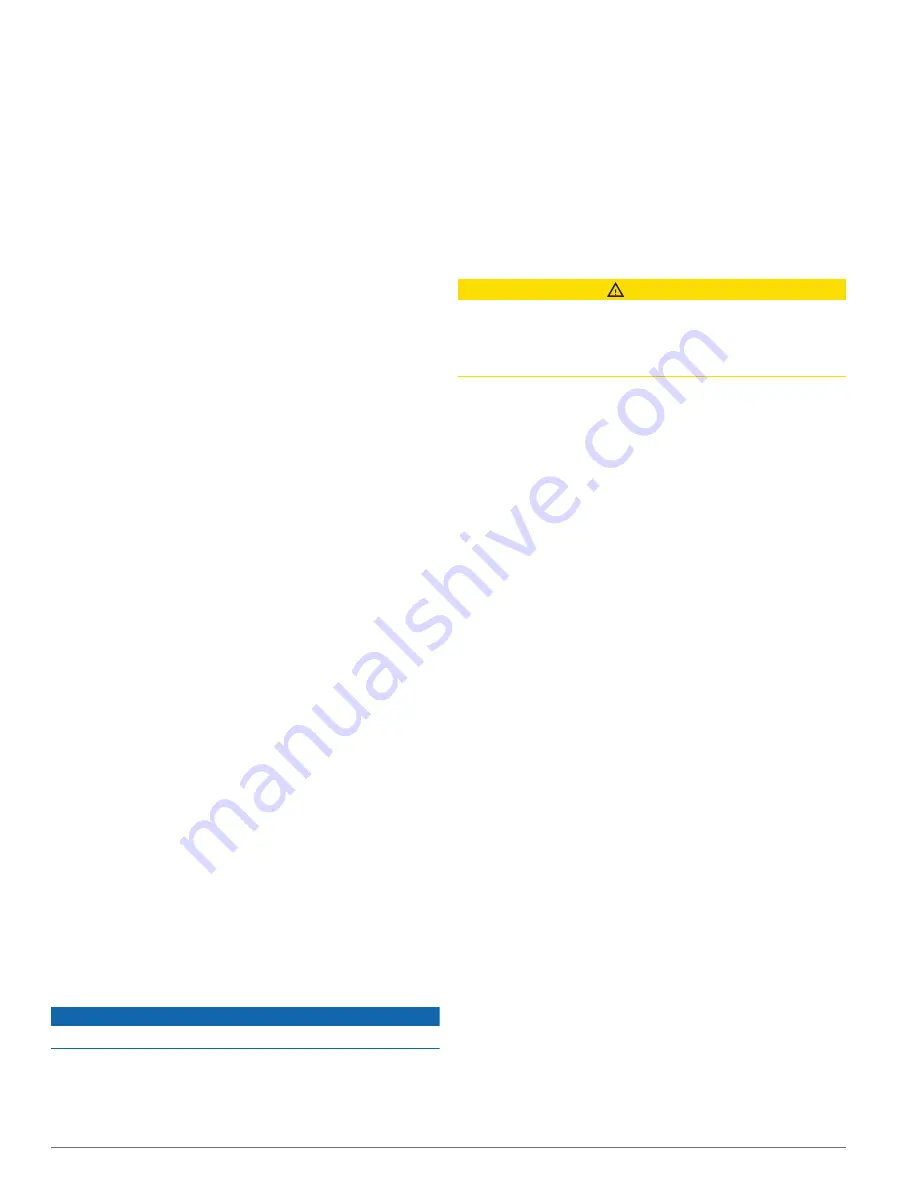
Changing the Data Shown in a Gauge
1
From a gauges screen, hold a gauge.
2
Select a gauge to edit.
3
Select
Replace Data
.
4
Select a data type.
5
Select the data to display.
Customizing the Gauges
You can add a gauge page, change the layout of the
gauge page, change how the gauges are displayed, and
change the data in each gauge.
1
Open a gauge page.
2
Select
Options
>
Edit Gauge Pages
.
3
If necessary, select a gauge view or gauge to edit.
4
Select an option:
• To change the data shown in a gauge, select the
gauge and select
Replace Data
.
• To change the layout of the gauges on the page,
select
Change Layout
.
• To add a page to this set of gauge pages, select
Add Page
.
• To remove a page from this set of gauge pages,
select
Remove Page
.
• To change the order of this page in the set of gauge
pages, select
Move Page Left
or
Move Page Right
.
• To restore this page to the original view, select
Restore Default View
.
Customizing Engine Gauge and Fuel Gauge Limits
You can configure the upper and lower limits and the
range of desired standard operation of a gauge.
NOTE:
Not all options are available for all gauges.
1
From an applicable gauges screen, select
Options
>
Set Gauge Limits
.
2
Select a gauge to customize.
3
Select an option:
• To set the minimum value of the standard operating
range, select
Rated Min.
.
• To set the maximum value of the standard operating
range, select
Rated Max.
.
• To set the lower limit of the gauge lower than the
rated minimum, select
Scale Min.
.
• To set the upper limit of the gauge higher than the
rated maximum, select
Scale Max.
.
4
Select the limit value.
5
Repeat steps 4 and 5 to set additional gauge limits.
Configuring the Tank Level Sensors
NOTICE
You must connect fuel sensors to inputs 1, 2, 3, or 4.
1
Select
Options
>
Settings
>
My Vessel
>
Seven
Marine Installation
>
Tank Preset
.
2
Select a tank level sensor to configure.
3
Select
Name
, enter a name, and select
Done
.
4
Select
Type
, and select the type of sensor.
5
Select
Style
, and select the style of sensor.
6
Select
Tank Capacity
, enter the capacity of the tank,
and select
Done
.
7
Select
Calibration
, and follow the on-screen
instructions to calibrate the tank levels.
If you do not calibrate the tank levels, the system uses
default settings for the tank levels.
Setting the Fuel Alarm
CAUTION
The Beeper setting must be turned on to make alarms
audible (
). Failure
to set audible alarms could lead to injury or property
damage.
You can set an alarm to sound when the total amount of
remaining onboard fuel reaches the level you specify.
1
Select
Options
>
Settings
>
Alarms
>
Fuel
.
2
If necessary, select a driveline.
3
Select
On
.
4
Enter the remaining amount of fuel that triggers the
alarm.
5
If necessary, repeat steps 2–4 for all drivelines.
Setting the Exhaust Aftertreatment System
(EATS) Mode
Read the Volvo Penta
Operator Manual
for more detailed
information.
When the chartplotter is connected to a compatible Volvo
Penta engine, it could be possible to select the Exhaust
Aftertreatment System (EATS) mode.
1
Select
Options
>
Settings
>
My Vessel
>
EATS
.
2
Select an option.
Adding Exhaust Aftertreatment System (EATS) Data to
a Gauge Page
When the chartplotter is connected to a compatible Volvo
Penta engine, it could be possible to select the following
gauges:
• UREA Level
• UREA Temp
• SCR Inlet Temp.
• SCR Outlet Temp.
• UREA Average Consumption
To view an EATS gauge, you need to add it to the gauge
page.
1
Select
Vessel
>
Engine
.
2
Select
Options
>
Edit Gauge Pages
.
3
Select a gauge to edit.
4
Select
Replace Data
>
Engine
.
5
Select the EATS data to display.
64
Gauges and Graphs






























